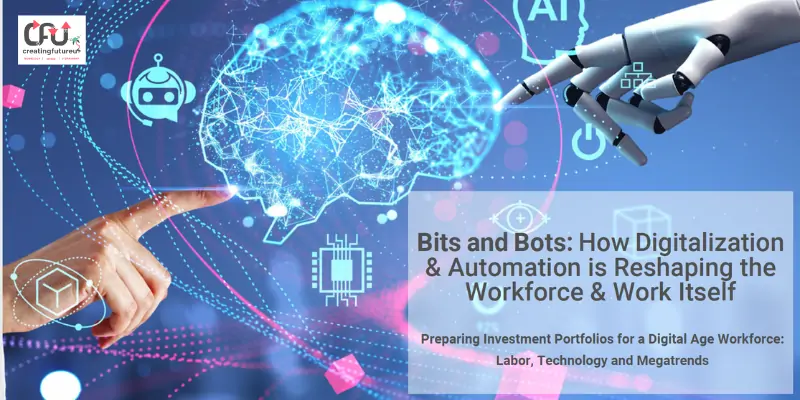Executive Summary
The world of work is experiencing a seismic transformation, brought on by advances in D&A. While there are demographic and psychological shifts underway, automation remains the largest contributor to changing workflows and roles.
Introduction
Digitalization and Automation (D&A) are already comprehensively impacting labor and workflows. Advances in AI, cloud, data use and apps, as well as robotics are converging to create a transformative revolution in the workplace, with far-reaching effects on its human capital. This will intersect with several megatrends that, altogether, will redistribute work along generational, geographic, cost-base, worker attitude and skill-set lines – creating a new class of winners and losers.
These tectonic shifts will have profound impacts on company strategies, risks, culture and valuations. This report explores the outcomes of D&A and these intersecting megatrends on three consequential areas: labor, decentralized work and ghost work, with a global overview across several sectors and industries of material interest to investor holdings.
Overview
The adoption of D&A varies across organizations, based on sector-specific circumstances, technological pace, cost considerations, and workforce demographics. Earlier phases of digitalization replaced physical and repetitive white-collar labor, but AI is poised to disrupt analysis, intelligence, and decision-making roles, affecting workers of all skill levels. This will result in the need for re-skilling. Regulatory efforts to manage this shift are in their infancy, but evolving. Accelerated by the Covid pandemic, a new decentralized work culture is emerging, presenting both opportunities and challenges for employers and workers alike. Legislation is slowly catching up to protect the rights of hybrid and remote workers. Additionally, the rise of “ghost work”—disconnected, poorly paid labor funneled through intermediary platforms—is drawing public attention, raising both ethical and reputational concerns for companies.
Deep Dives Across Key Sectors
Four sector and one industry group deep dives provide a detailed analysis of how the transformation in these areas is affecting the workforce and workflows. Each deep dive provides an overview of its market and workers, assesses and analyses the impacts resulting from hardware (e.g. robotics, sensors, drones), cloud, data use and applications, as well as AI (including foundational models), whilst providing relevant case studies. The deep dives also provide sector-level guidance on emerging risks for corporates and potential areas for investor engagement.
- Healthcare
- Financials
- Consumer Staples
- Transportation
- Industrials
Stakeholder Responsibility
Governments – including via partnerships with the private sector, regulators, academic institutions, industry groups, trade unions, corporate leaders and investors all have an important role to play in ensuring that the transition to a digital age works for all stakeholders equally. The report examines some of the roles and responsibilities of these key groups in more detail.
Conclusion
Complexity is escalating in the digital age due to the convergence of exponential technologies with five key megatrends, driven primarily by D&A. This will contribute to a broad hollowing out of tasks and roles. These shifts result in several critical outcomes: a reduction in entry-level work, a need for flexibility from both employers and employees and the heightened importance of reskilling and effective human capital management for sustaining company value.
Investors can respond to these trends and outcomes by asking questions around anticipating or operationalizing human capital management, seeking robust examples of D&A transitions, aggregating and tracking best practices that anticipate regulations, and assessing the efficacy of training programs that reskill and upskill workers.
Table of Contents
-
Executive Summary
-
Introduction
-
Overview
-
Sector Deep Dives
- Healthcare
- Finance
- Consumer Staples
- Transportation
- Industrials (Ex-Transportation)
-
Stakeholder Responsibility Map
-
Conclusion

